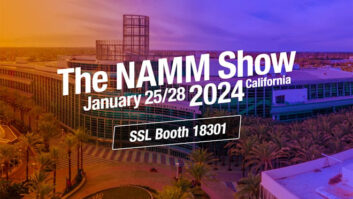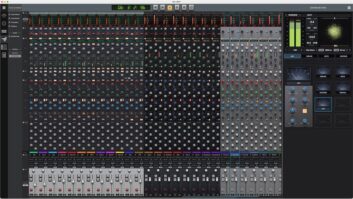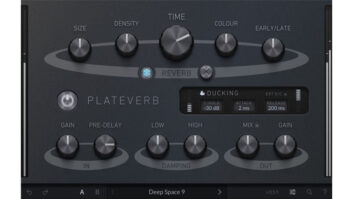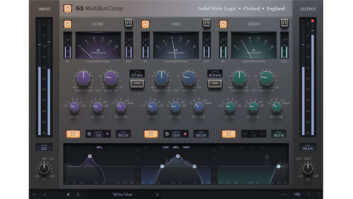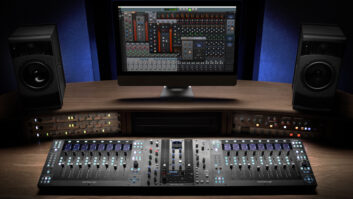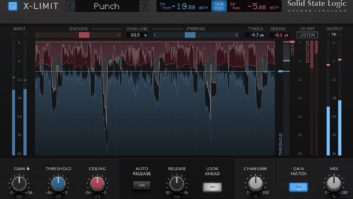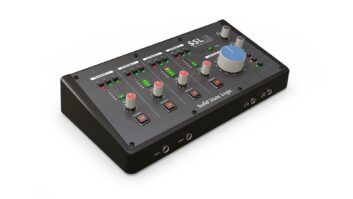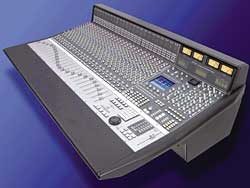

Iwork with producers Jimmy Jam and Terry Lewis in their Flyte Tyme Productions studios, in Santa Monica, Calif. When we began thinking about gear for the new five-room facility, we considered building custom consoles with a great-sounding monitor section, DAW control, mic preamps, EQs and quality metering. Then SSL released the AWS 900 and we bought five. Here are some of our tricks for using the AWS for tracking, mixing and everything in-between.
TRACKING LIVE
While tracking, I use the AWS as a front end to Pro Tools. I generally get my rough mixes completely in the box, placing my stereo Pro Tools output into the AWS’ external input section. This lets me route my console mic/line inputs to the SSL Mix bus and to Pro Tools’ direct inputs so our production team can actually hear themselves in case I switch between Pro Tools sessions, or if the computer is off and somebody just wants to work on a song.
When I’m ready to start tracking, I can toggle between my SSL Mix bus and the Pro Tools 2-track output, giving me some nice control over what I hear. I generally stick to a 2-channel, in-the-box Pro Tools rough mix while tracking, unless I’m tracking vocals. Then I keep analog channels 1 through 4 on the console open for Pro Tools outputs, routed to the SSL Record bus. This way, I can stem out a separate vocal bus for the singer and he/she can change the vocal levels on a private cue mixer in the booth. In this mode, I monitor the 4-channel stem mix via the SSL Record bus — essentially, SSL mix bus 2.
FAST VOCAL PRODUCTION
Most Pro Tools users record vocals with a keyboard and a mouse; I do things a little differently. Usually, I set up 20 or so vocal tracks, some for leads and some for backgrounds. Jimmy and Terry like to avoid using layered playlists in Pro Tools for vocal recording because it’s hard to instantly see what we have recorded, and it’s an extra step when it comes to comping vocals if you want to quickly mute/un-mute takes using only the console faders and transport for playback. Working this way, we lay out the tracks we want to record to, see them on the AMS 900’s DAW control layer and arm those tracks to record while we can change fader, pan, send levels, playback, record, punch-in, solo, mute and locate from the console. I can stay in the middle of the console — in-between the speakers — without a distracting computer screen in my face. It’s a refreshing way to work, and I can always hop over to the computer screen to do a quick edit if necessary.
This method is also nice for figuring out vocal comps before putting them together. By the end of the vocal tracking, Jimmy usually has a complete map of the comps he’s going to use. He plays back the sections he likes and confirms his notes by muting/un-muting takes without having to rely on someone else immediately editing the pieces together for him. Once he confirms his comp map, we can quickly assemble it in the computer.
REFERENCE MONITORING
The AWS 900’s flexible monitor section can accommodate most anything you send into it. I usually have several different external 2-track playbacks patched in, along with my Pro Tools mixes. I can easily reference previous rough mixes and tracks that capture an energy I am looking to build in my current project. I play these reference mixes in real time — in my Pro Tools session — lined up with the timing of my current project, assigned to different outputs than my mix is assigned to so I can seamlessly A/B between the mix and references.
THE BASS BUMP
The console’s bass management can output an LFE channel for surround or stereo. When mixing 2-channel material, I usually listen to my small speakers — flat with no subs attached — but sometimes during writing sessions where the producers want to feel an extra bottom-end punch, turning on the bass management provides more power and reduces the stress on my speakers at higher volumes, avoiding a lot of blown drivers. In the monitor section, press Monitor Options, select Bass, and then select 80 and BMN.
THE MIX
We have 32 Pro Tools outputs and use all of them when mixing. In the end, we have about 30 tracks — 15 stereo submix stems — coming out of Pro Tools and into the AWS’ analog channels and aux returns, with another stereo output for playing reference mixes. From here I add compression to the stereo mix from the AWS’ center-section stereo compressor. I may use a little channel EQ here and there, or some filters, and a couple key channel inserts on drums/bass, etc.; combined with the submixing and plug-ins in Pro Tools, we get a powerful mix, using the best of both analog and digital.
I store console recall settings in my Pro Tools session as MIDI sys ex data and my assistant writes channel-insert outboard gear settings directly in the corresponding tracks’ comment field. This way, all recall data is easily found for both the console and outboard gear, and we can easily get a mix back up.
Matt Marrin is a freelance engineer. Visit him at
www.mattmarrin.com.

WATCH:
Videos on the SSL AWS 900e
